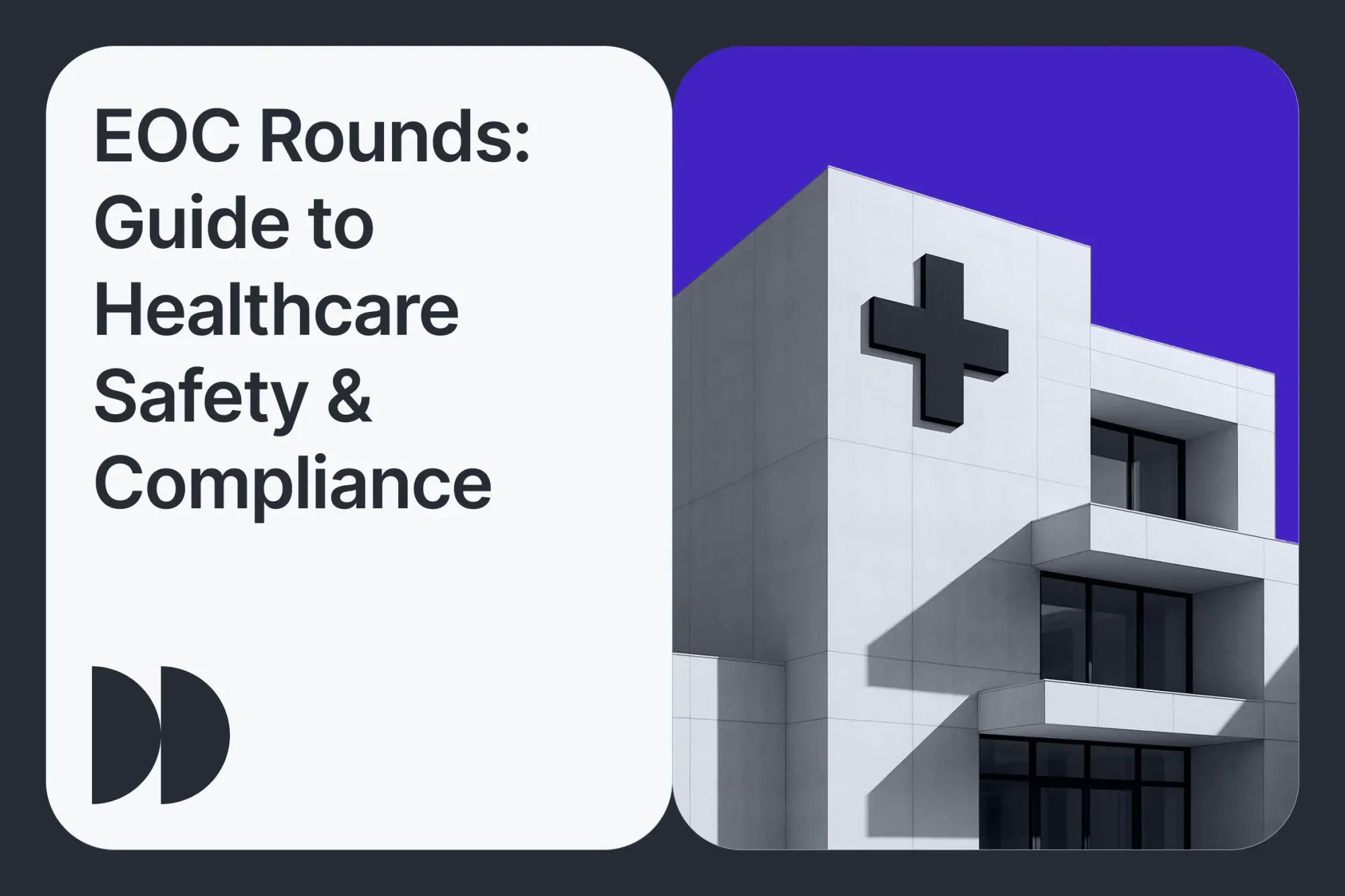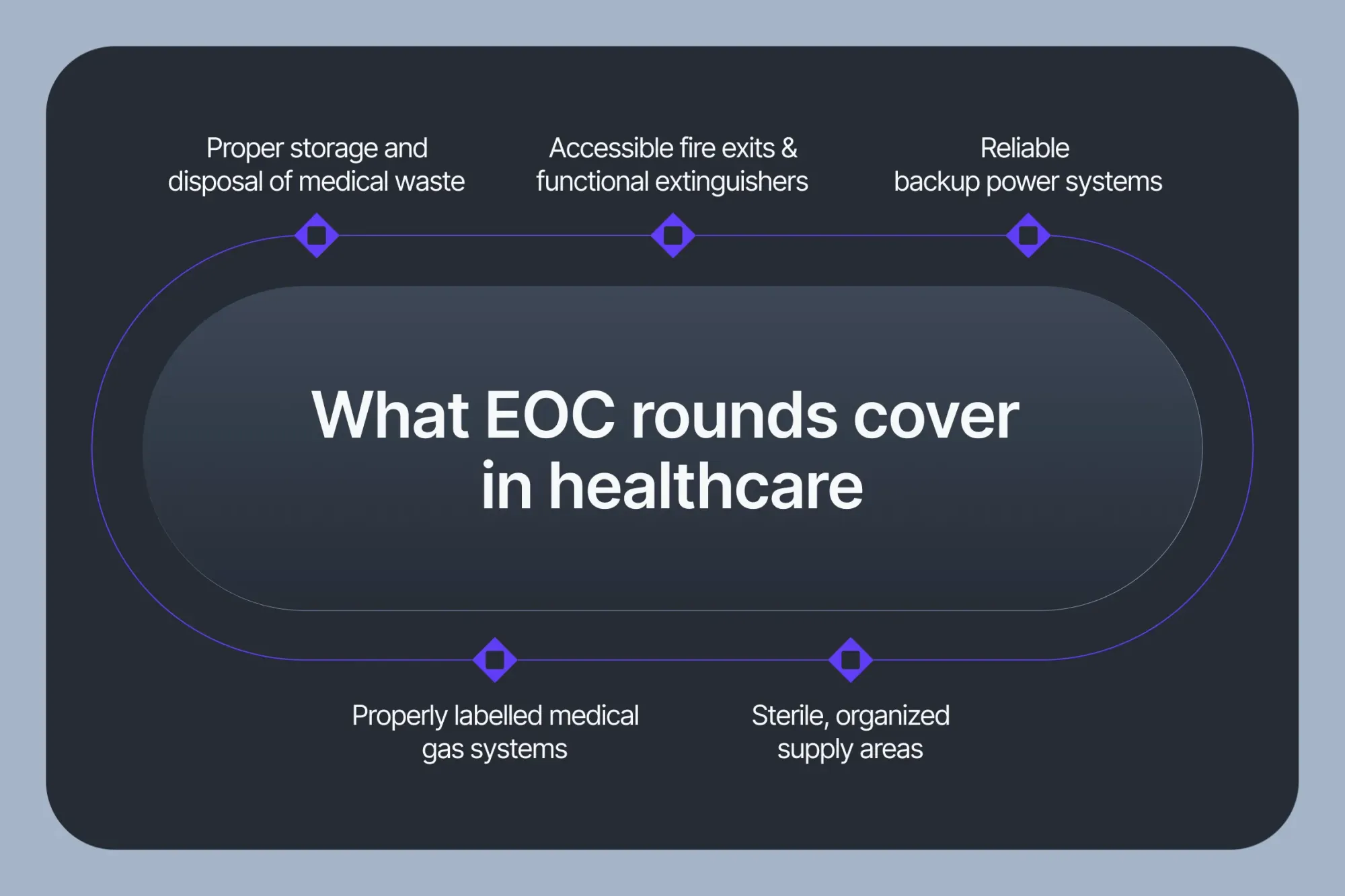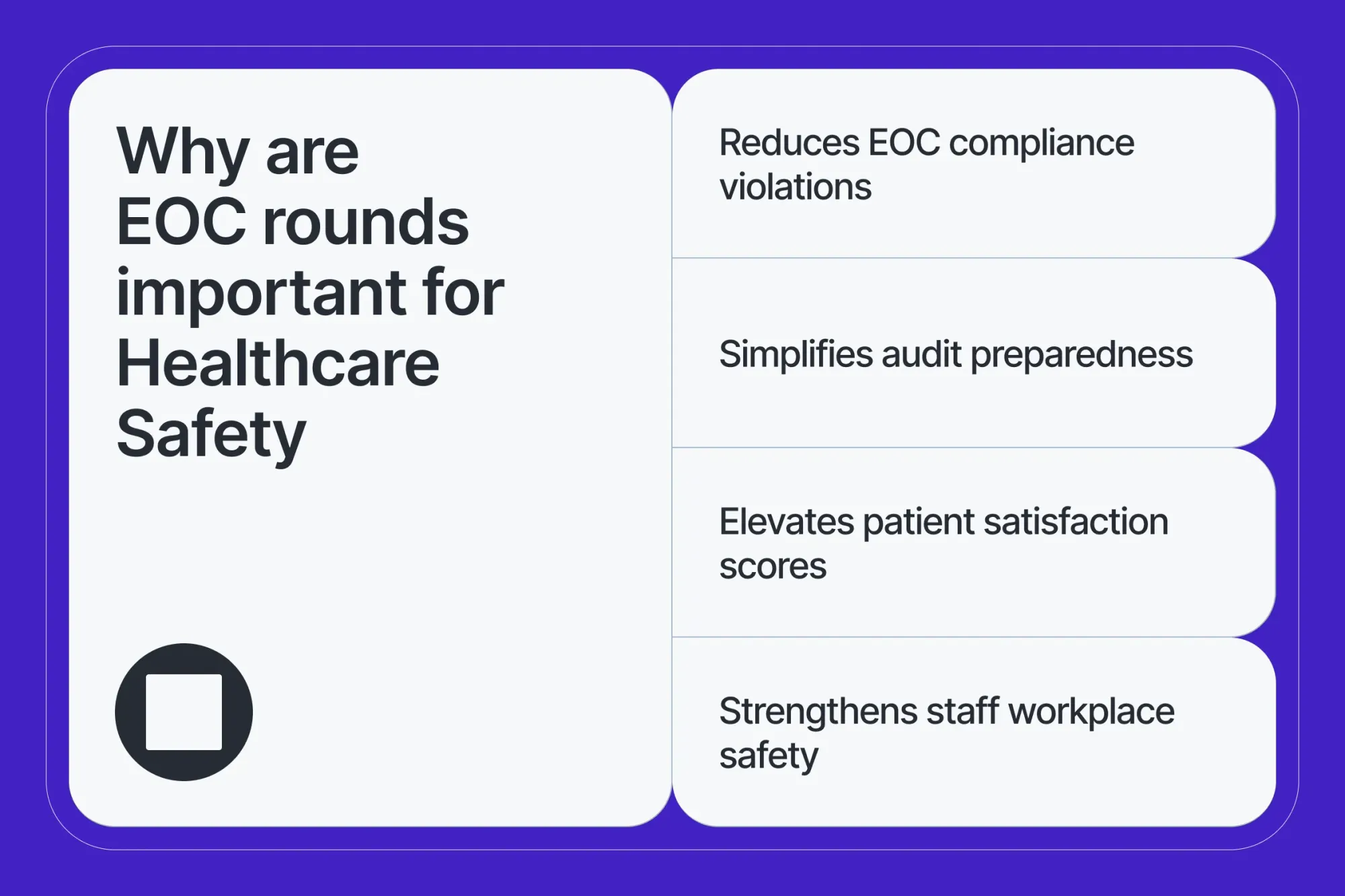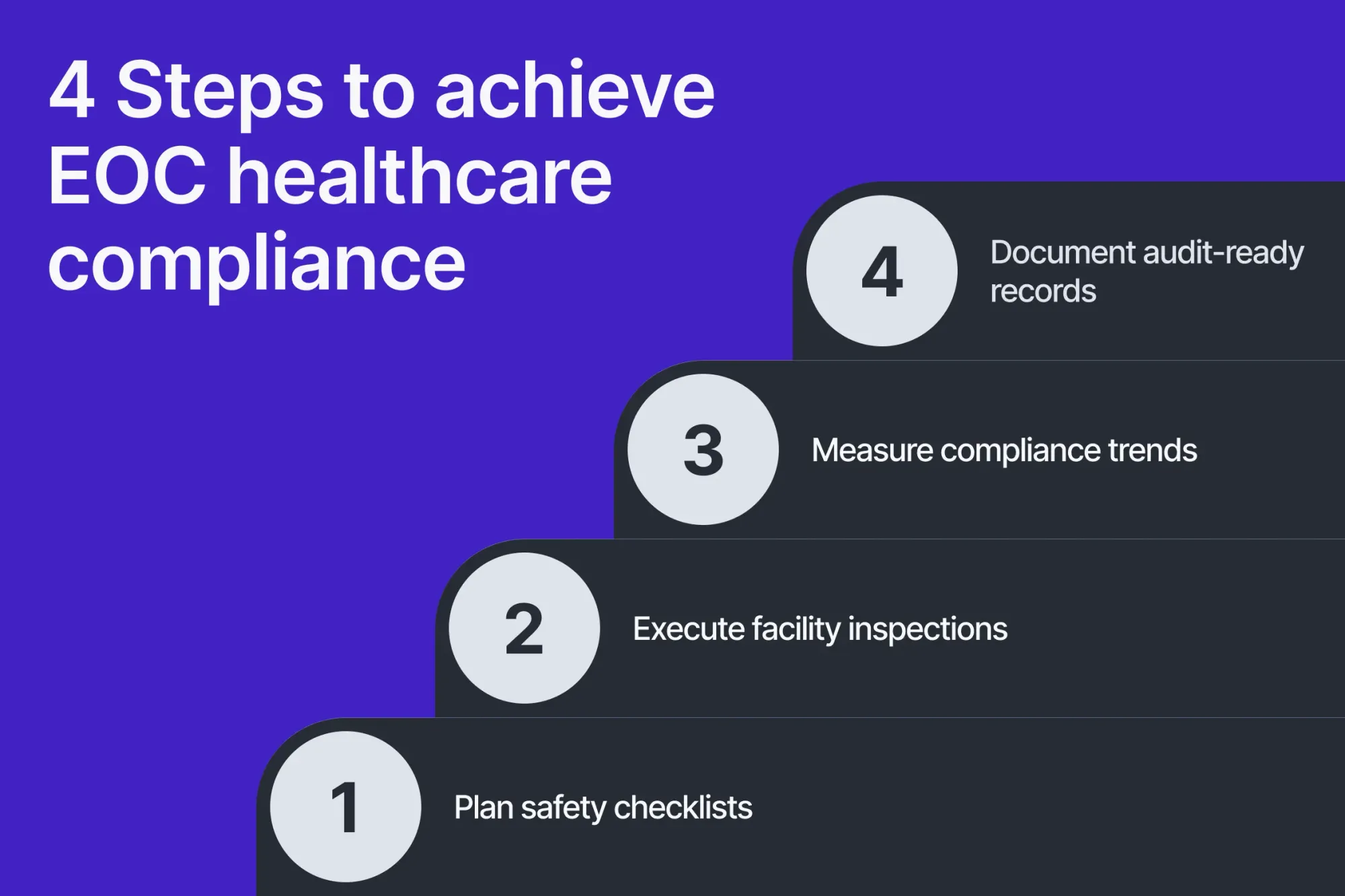
A hospital can have the best clinicians in the world, but if the environment isn’t safe, care breaks down fast. When it comes to delivering safe and high-quality healthcare, what happens outside the operating room is just as critical as what happens inside it.
That’s where the Environment of Care rounds come in.
In this guide, we’ll explore:
- The meaning of EOC in healthcare
- Why EOC rounds are important for safety and compliance
- What happens during these inspections
- How to ensure EOC healthcare compliance
- Actionable steps to strengthen your EOC program
Whether you’re a Facilities Manager, Nursing Director, Safety Officer, Infection Control Specialist or a Compliance Officer in the healthcare industry, this guide provides clarity and tools to enhance your EOC strategy.
EOC Meaning in Medical Care
In the context of healthcare, Environment of Care refers to the physical environment in which patient care is delivered, including fire safety, medical equipment, infection control, sterilization processes, and emergency protocols.
Unlike common misconceptions, EOC isn’t about the end of care but rather the infrastructure that enables it.
These rounds include systematic inspections to ensure the hospitals meet safety and healthcare facility compliance standards set by the Centers for Medicare & Medicaid Services (CMS) and The Joint Commission (TJC).

Where is it inspected? Everywhere - from high-risk areas like ICUs to public corridors, utility closets, storage rooms, and mechanical spaces must be inspected. Non-compliance can lead to CMS fines, TJC citations, or safety risks like delayed evacuations.
Who does what? Different departments are responsible for different areas. Facilities teams manage critical infrastructure like backup generators and HVAC systems, infection control oversees sterilization and sanitation protocols, safety officers verify fire exits and extinguishers, and nursing leads ensure patient areas meet hygiene standards.
Why does this matter? Because every detail, no matter how small, can have real consequences. A blocked exit could slow down an evacuation. An expired fire extinguisher could result in failure to control a fire effectively, risking patient and staff safety. A frayed electrical wire could spark a fire, as seen in a 2024 TJC-cited incident costing a hospital $75,000 in repairs (Joint Commission, 2024).
Why are EOC Rounds Important ?

Facilities that treat EOC rounds as a strategic priority, not a checkbox, often see the following advantages:
- Reduces EOC Compliance Violations - A 2024 TJC audit found 80% of hospitals with EOC programs avoided citations and were able to save thousands in fines (Joint Commission, 2024)
- Simplifies Audit Preparedness - Consistent EOC rounds ensure audit-ready documentation with fewer deficiencies, streamlining CMS and TJC reviews (CMS, 2023)
- Elevates Patient Satisfaction Scores - Hospitals with safe, clean environments report up to 15% higher HCAHPS scores, as patients feel more confident in well-maintained facilities (CMS HCAHPS Survey, 2023)
- Strengthens Staff Workplace Safety - EOC rounds reduce hazards in the workplace(e.g., faulty wiring, clutter), lowering staff injury rates by 20%, per a 2025 OSHA study (OSHA Healthcare Safety, 2025).
What Happens During an EOC Healthcare Round?
It starts with a structured walk-through by safety or facilities teams to verify compliance with standards like TJC’s EC.02.03.05 (fire protection) and EC.02.06.01 (building safety).
Their goal: ensure every part of the hospital complies with safety and operational standards.
A typical EOC healthcare round includes checks on:
Ensuring EOC Healthcare Compliance: 4 Key Steps

To meet CMS §482.41 and TJC standards, follow this four-part framework:
1. Plan Safety Checklists
- Build a standardised checklist aligned with CMS/TJC regulations.
- Assign roles ( e.g., facilities for generators, infection control for sanitation).
- Map items to standards like EC.02.05.01 (utility systems).
2. Execute Facility Inspections
- Schedule regular walk-throughs across all shifts and departments.
- Encourage staff participation with awareness campaigns
- Include high-risk areas like surgical units.
3. Measure Compliance Trends
- Log findings in real-time using digital tools.
- Use heat maps and trends to detect repeat issues
- Track closure rates
4. Document Audit-Ready Records
- Maintain proof of every round
- Use CMMS platforms to store reports, photos, and timestamps
- Be audit-ready at any time
How to Improve EOC Medical Rounds in Your Healthcare Facility

Here are 5 actionable tips to level up your healthcare program:
- Standardize Inspection Checklists - Ensure consistent inspections across teams
- Train Multidisciplinary Teams - Involve nursing, maintenance, and infection control teams.
- Implement Digital CMMS Tools - Switch from paper to a CMMS for real-time tracking and accountability.
- Analyze Issue Trends - Identify recurring issues and address root causes.
- Ensure Action Follow-Up - Log issues and track them until closure.
How to get it all done? Achieving safe and compliant healthcare facilities through EOC rounds requires a lot of precision and coordination. Many hospitals use CMMS software to rotate departments weekly or monthly, standardize checklists, train multidisciplinary teams, find documents digitally, and ensure nothing is missed.
For instance, Facilio’s dedicated healthcare CMMS uses real-time task automation, assigning roles across facilities such as infection control and safety teams. By using actionable analytics, Facilio helps you track the trends, minimize compliance violations, and prioritize patient and staff safety, which makes the vital EOC rounds feel like a simple, everyday task.
Ready to see how it works?
Get in touch
And learn how our solution can help you integrate disparate solutions across portfolios.
SEE A DEMOFrequently Asked Questions
What does EOC stand for in healthcare?
EOC stands for Environment of Care, covering safety, security, and operational systems in healthcare facilities
How often should these rounds be done?
Most hospitals conduct monthly rounds, with weekly checks in high-risk areas, such as ICUs, as per TJC guidelines.
Who performs these rounds?
A multidisciplinary team, including facilities managers, infection control officers, and nursing leads, often with external consultants.
What are common EOC violations?
Examples include blocked exits, improper waste storage, and outdated equipment logs, which can lead to CMS fines or TJC citations.
